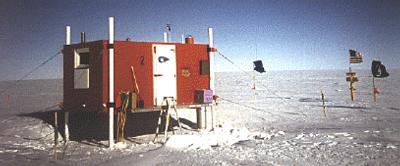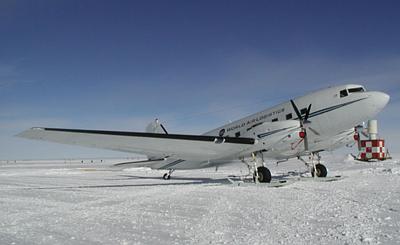
|
|
16 December, 2000
Automated Geophysical Observatory (AGO)
Occasionally, we get people passing though the South Pole Station on their
way to remote sites in Antarctica. Today 6 such people were in town; the
AGO folks (pronounced EH-go). There are 6 Automated Geophysical
Observatory (AGO) sites around Antarctica (see map). The sites are
located long a straight line, from the geomagnetic south pole: the point
where the field lines appear to gather from space. This is a slightly
different location from the magnetic south pole, and is important for the
solar wind observations in the upper atmosphere.
Each AGO site has a small 8’x8’x16’ building which houses everything the
observatory needs to run for the next year. Outside of the building are
antennae that receive the signals that will be collected and analyzed.
Each station collects meteorological data (temperature, pressure, wind
speed and direction) in addition to seismic data, and information about
the solar wind and magnetic field. One main goal of these sites is to
observe the interaction between the solar wind and the Earths magnetic
field. The AGO sites are uninhabited, with the exception of a few weeks in
the summer when a few people go to these sites to collect the data that
the observatory has been gathering in the last year, and do any
maintenance on the facility.
The site is reached by a modified DC3, that is equipped with skis and can
land on unprepared snow. The sites are small, and are difficult to see
before the plane gets to the building. The site locations are known
precisely, and a global positioning system (GPS) is necessary to find
them. Once the DC3 has dropped off the AGO crew, they make camp. They
live in small tents, since the AGO buildings aren’t big enough for living
quarters. During the time that the crew is at an AGO site, they prepare a
landing strip for an LC-130. The large cargo planes will come in to drop
off large amounts of fuel that will keep the observatory running for the
next year, and pick up the crew. The fuel is too heavy to be brought in
by the DC3. The fuel is offloaded from the back of the LC-130 while the
plane is moving. The plane slows down and opens the door at the back of
the cargo bay as it taxis down the skiway, and then suddenly speeds up
when it reaches the place where the fuel needs to be. The inertia of the
fuel results in it sliding out the back of the plane. The fuel is put in
the proper location for the next year, and then the AGO crew says goodbye
to the station for another year and moves to the next site.

Map of the AGO sites in Antarctica

This is one of the AGO buildings. Image from the AGO web page, space.augsburg.edu/ago

This is the modified DC3 that lands at smaller camps throughout Antarctica.
Contact the TEA in the field at
.
If you cannot connect through your browser, copy the
TEA's e-mail address in the "To:" line of
your favorite e-mail package.
|
